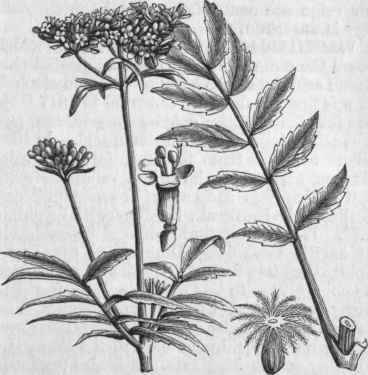Valerian (Lat. Valere To Be Well)
Description
This section is from "The American Cyclopaedia", by George Ripley And Charles A. Dana. Also available from Amazon: The New American Cyclopędia. 16 volumes complete..
Valerian (Lat. Valere To Be Well)
Valerian (Lat. Valere To Be Well), a genus of monopetalous plants, Valeriana, which with a few others makes up the family valerianacece. On account of a similarity in the structure of the individual flowers, the family in a systematic arrangement stands near composite, though they are not, as in that order, collected into a head, but in a corymb or cyme. In valerian the inferior ovary has one fertile oneovuled cell, and two empty or abortive ones; the adherent calyx has its limb developed as several plumose bristles, which are rolled inward in flower, but as the fruit matures expand as a pappus; the tube of the corolla is usually gibbous, or swollen at one side near the base, and the limb has five nearly regular lobes; stamens three. There are about 150 species, mostly perennial herbs, with thickened roots, which are strong-smelling when dry, entire or divided leaves, and white or rose-colored flowers; they are widely distributed, but most abundant in mountainous regions; three are natives of the northern states, but rather rare and local.
The most important of these is the edible valerian ( V. edulis), so called because its large spindle-shaped root, sometimes a foot long, is roasted and eaten by the western Indians; its leaves are fringedciliate, and its stem, 1 to 4 ft. high, bears an interrupted panicle of whitish flowers. V. paucijlora is found from Pennsylvania and Ohio southward, while the first named and V. sylvestris, our third native species, are northern and western. The best known of all the species is V. officinalis, the root of which is the medicinal valerian, and the plant is quite common in gardens, where it is cultivated for the fragrance of its flowers; the leaves have from 11 to 21 oblong, cut-toothed, somewhat downy leaflets; the stem, 2 to 3 ft. high, bears a broad, terminal corymb of small white flowers, often tinged with pink, with an odor like that of heliotrope, on which account it is often called garden heliotrope. A closely related species, with less divided leaves, V. phu, is also cultivated. The medicinal species is found all over Europe, from Spain to Iceland, and in northern Asia, and is cultivated in England and sparingly in this country for its roots; it has an erect rootstock, to which are attached numerous rootlets 3 to 4 in. long; the rootstock is usually cut to facilitate drying. "When freshly dug the root has no characteristic odor, but when dry it has a peculiar terebinthine or camphorous odor, and a bitterish aromatic taste.
The chemical composition of the root is somewhat complex; when fresh it gives from ½ to 2 per cent, of volatile oil; the dried root yields less oil, with valerianic acid, which results from the oxidation of the oil during the drying, and a resinous substance; the changes which take place in the root, and the different products, have not been well studied. Valerian has long been used in medicine, and it is supposed that the phu mentioned by Dioscorides and other ancient writers was this plant. In the 16th century it was used in England to flavor soups and pottages, and the roots, though the odor is now disagreeable to most persons, were placed among clothes as a perfume. Cats are exceedingly fond of the odor; a piece of the root seems to intoxicate them. Valerian belongs to that class of nervous stimulants known as antispasmodics, and in hysteria and other affections of women it is used in both domestic and regular practice; it is administered in the form of infusion, tincture, and fluid extract. - The valerian family includes centranthus, of which several species are cultivated as ornamental plants, and fedia, of which F. olitoria is cultivated, and is known as corn salad.

Valerian (Valeriana officinalis).
Continue to:


